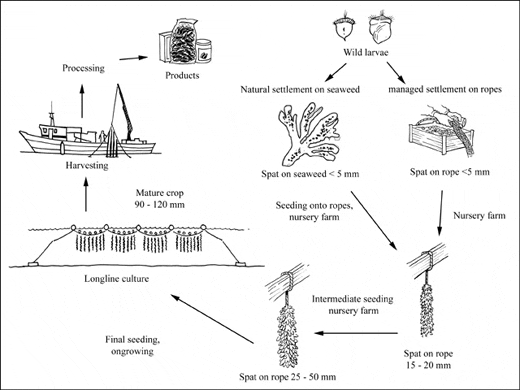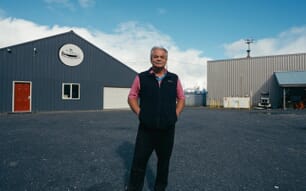Habitat and biology
Perna canaliculus is endemic to New Zealand. It occurs throughout the country but it is more common in the warmer North. It prefers moderately exposed situations and full salinity. Mussel farming is restricted to areas that are suitable with respect to its biology (high subtidal) and the sea conditions (sheltered in-shore areas). The major growing areas are Coromandel, Marlborough Sounds, and Stewart Island. In New Zealand's moderate climate, P. canaliculus grows to 90-100 mm (normal harvest size) in 18-24 months
Production cycle

Production systems
Seed supply
The first stage involves the procurement of spat (seed) for ongrowing on the culture ropes. Spat comes from two sources:
- Farmers suspend spat catching lines in areas that are known to produce high numbers of planktonic larvae ready to settle. A spat settlement monitoring programme carried out by the New Zealand Marine Farmers Association and personal experience provide a guideline, but results can be variable. Spat catching on ropes is costly and provides a small portion of the total spat required, but this spat tends to be of high quality.
- A natural phenomenon which occurs on the North West Coast of the North Island of New Zealand provides the major source of spat. At irregular times throughout the year considerable quantities of newly settled spat attached to seaweed are washed up on the beaches in the region of Kaitaia. The seaweed is collected by local people and then carefully and quickly transported to growers in other parts of the country.
Currently, the industry is entirely based on the use of wild spat. However, the technology for small scale hatchery seed production has been established in New Zealand and commercial-scale hatchery seed production is expected within 5 years.
Nursery
Upon arrival at the farm, the spat is resettled onto nursery lines. This is done by holding the seaweed against the nursery rope with a light continuous tubular cotton stocking. The seed mussels attach to the rope within hours. The stocking and seaweed biodegrade within weeks. A seeding density of 1000 to 5000 spat per metre is optimal. It is important to minimise stresses such as heat and dehydration on the spat throughout harvesting, transport and reseeding. Predation is a limiting factor. Small mussels are vulnerable to predation by various fish species (snapper, spotty, leather jacket): nursery lines are kept in areas with low fish abundance, and recreational fishers are welcomed by the growers to tie up to the farm and fish from it.
Fast and highly manoeuvrable vessels are used for nursery and longline seeding and carrying out of maintenance and inspection chores. Special vessels are used for the initial anchoring and setting up of longlines together with the task of underwater inspections and replacements as necessary.
Ongrowing techniques
The siting of mussel farms is governed by several factors. Clean unpolluted water is the most essential consideration, followed by the need to site farms in areas of relatively calm sea conditions and out of the effect of ocean swells. Care has to be taken not to site farms where they will interfere with or impede the passage of vessels of all types. Water depth is also important, with most farms being in depths of 5-30 m.
Mussel farming in New Zealand is carried out on longlines. A longline is typically 110 m long and consists of two strong parallel ropes separated by plastic floats that are about 1.2 m long. The longlines are anchored at both ends on the seafloor with concrete or screw anchors. The cultivation rope hangs in loops of 5-10 m depth from the longline. A typical cultivation rope is 3500 m long and carries 40 tonnes of mussels at harvest. As the weight of the crop increases during the growth of the mussels, more floats are tied between the longline 'backbone'. The average area is between 3 and 5 ha, although farms may vary from 1 to 20 or more hectares. The shape of the boundary is determined by the geography of the area and water depth. Much bigger farms are currently planned. Where necessary, navigational channels are provided between farms to give ready access to and from shore.
After 3-6 months growth on the nursery rope, the juveniles (10-30 mm) are stripped from the ropes and seeded at a rate of 150-200/m onto a thicker rope, using a larger diameter cotton stocking to once again secure them until they attach to the rope of their own accord. This rope is then fixed in loops to the surface longline where it will remain until harvest time. As before, the cotton stocking is biodegraded after the mussels have firmly attached to the growing rope.
The duration of the growing cycle varies from site to site and depends on the number of mussels per metre of rope, food concentration (plankton, detritus), temperature, and water movement. It takes 12-18 months from final seeding to achieving 90-120 mm mussels. Farmed mussels reach market size about twice as fast as wild mussels growing in close proximity, and they retain the green shell colour. Low-intensity monitoring of crop and installations is required during the ongrowing period.
The vessels used for New Zealand mussel farming today are a far cry from those used in the days of development in the 1960s and 1970s. The first boats were small launches or fishing vessels which were used for every phase of the job, from spat collecting through to harvesting and delivery. The use of these small boats meant that the work was very labour-intensive, physically demanding and time-consuming. The rapid increase in production over the past three decades, coupled with an obvious need for innovation, has seen the development of a new style of fleet in the mussel industry. Today's vessels are highly specialised.
Harvesting techniques
Harvesting, which was originally carried out by hand and then largely by towed barges, is now done by specially designed large harvesting vessels. These are fitted with a complex array of efficient purpose-designed labour-saving equipment. A series of in-line mini-cranes progressively raise the heavy mussel-laden longline to where the hydraulic stripper pares the mussels from the culture rope. The rope is automatically fed into a container bag for cleaning ashore and later re-use. The mussels are stripped from the ropes and then pass into a revolving drum. This drum, with its high pressure water jets and revolving action, both cleans and de-clumps the mussels. They are then deposited onto moving belts for sorting. Broken shells are discarded. The clean live mussels are packed into specially designed one tonne transporting bags or 25 kg wholesale sacks for the local market. The vessel's on-board crane is used to stack the full sacks along the deck as they are progressively filled. These self-contained harvesting units employ a crew of three to six people depending on size. The larger vessels can harvest >100 tonnes of washed, separated, ready-for-processing mussels in a day's work. As they are self-propelled, it never takes long from the farm site to delivery at the nearest unloading point. These specialist vessels are all of shallow draught so that the state of the tide will not unnecessarily delay access to wharves or slow the delivery process. The combined use of shore facilities and the vessel's own crane ensures that the unloading process is swift.
The size of the mussels largely determines the harvest time. Different markets demand specific sizes, or product forms, or both, and accordingly size is often an important consideration when deciding when to harvest any particular crop. Mussels destined for the half-shell markets are generally harvested earlier than those required for use as whole individually quick frozen (IQF) mussel meat.
Because there is no set season when mussels might spawn, care is taken to harvest them at their peak condition. Before harvesting a line, samples are inspected to ensure that the mussels are fat and succulent and not thin from having spawned in the days preceding harvest. Contract harvesters are experienced in making these judgements and inform growers accordingly. The industry is careful to ensure that only mussels in top condition enter the processing chain and go on to the marketplace, whether it is domestic or international.
Harvesting is carefully synchronised with factory production schedules in order to maintain top quality and comply with hygiene standards. Even though the mussels can stay alive for several days out of water, the time from harvesting to processing is kept to a few hours. The transport chain from harvesting on the farm through to the factory is carefully organised so that processing capacity matches the harvesting rate on a day-to-day basis. Mussels are harvested into 1 tonne synthetic bags on board the harvesting vessels. These specially designed bags allow the mussels to breathe during transport and provide a very efficient means of handling. All mussels must be alive before entering the processing phase.
Handling and processing
New Zealand mussels are processed in state-of-the-art high-tech factories that operate under very strict hygiene and quality control regimes that are determined by both New Zealand Government regulations and international food processing standards. Regular inspections are carried out by Government inspectors, and each factory runs its quality programme.
The mussels are processed into many product forms (see Market and Trade section) but, regardless of the final form, the flow through the processing chain is very rapid. The bulk of production takes little more than thirty minutes from the beginning of the cycle until final packaging. All plants use extremely quick-freezing spiral freezers and most utilise automatic weighing and packaging equipment.
August 2009





